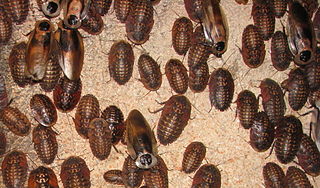
Giant cockroaches, or blaberids, are the second-largest cockroach family by number of species. Mostly distributed in warmer climates worldwide, this family is based on the American genus Blaberus, but much of the diversity is also found in Africa and Asia.

An ootheca is a type of egg capsule made by any member of a variety of species including mollusks, mantises, and cockroaches.

The American cockroach is the largest species of common cockroach, and often considered a pest. In certain regions of the U.S. it is colloquially known as the waterbug, though it is not a true waterbug since it is not aquatic. It is also known as the ship cockroach, kakerlac, and Bombay canary. It is often misidentified as a palmetto bug.

The Florida woods cockroach is a large cockroach species which typically grows to a length of 30–40 mm (1.2–1.6 in). When alarmed, adults can eject an extremely foul-smelling directional spray up to 1 m, which inspired several of its other common names: Florida skunk roach, Florida stinkroach, skunk cockroach, skunk roach, stinking cockroach, and stinkroach. Two other naming variations include Florida cockroach and Florida woods roach.

The Surinam cockroach or greenhouse cockroach is a species of burrowing cockroach. It is a common plant pest endemic to the Indomalayan realm that has spread to tropical and into subtropical regions around the world, and in isolated populations to temperate climates where protective habitat such as greenhouses provide shelter for individuals inadvertently shipped in the soil of plants. Its populations are almost exclusively female, and it reproduces through parthenogenesis, having evolved several clonal strains from its sexual progenitor P. indicus.

Parcoblatta virginica, the Virginia wood cockroach, is a small cockroach species of the genus Parcoblatta, measuring about a centimeter long as an adult.

Cockroaches are insects belonging to the order Blattodea (Blattaria). About 30 cockroach species out of 4,600 are associated with human habitats. Some species are well-known pests.

The giant burrowing cockroach is also known as the rhinoceros cockroach, and Queensland giant cockroach. These cockroaches are native to Australia and mostly found in tropical and subtropical parts of Queensland. They are the world's heaviest species of cockroach and can weigh up to 30-35 grams and measure up to 7.5-8 cm (3.1 in) in length. It is a member of the family Blaberidae, which contains hundreds of species. It is part of the blaberid subfamily Geoscapheinae. It is prominent in the wild and can also be sold and kept as a pet.

The death's head cockroach is a species of cockroach belonging to the family Blaberidae. It is often confused with the discoid cockroach, Blaberus discoidalis, due to its similar appearance. It is distinguished by jet black cloak-like marking on its wings and a skull-shaped, amber/black marking on its pronotum. The name death's head comes from the markings on the top of the pronotum: "cranii", which is Latin for "of the head", and "fer", meaning "carry" or "carrier". Due to their unique appearance and certain characteristics, they make an easy to care for pet or display insect for entomologists and hobbyists.

Blaberus giganteus, the Central American giant cave cockroach or Brazilian cockroach, is a cockroach belonging to the family Blaberidae. One of the world's largest cockroaches, it is native to the warm parts of the Neotropical realm.

Blaberus is a genus of cockroaches native to the Neotropics found in the Americas. More than 30 species are in the genus, and some of them are popular among hobbyists as pets or as feed for other arthropods. Unlike several genera of cockroaches considered to be pests, this genus keeps its ootheca in its abdomen until the time it hatches. They generally require a relative humidity of 60% or higher to thrive and temperatures above 25 °C to reproduce.

Blaptica dubia, the dubia roach, orange-spotted roach, Guyana spotted roach, or Argentinian wood roach, is a medium-sized species of cockroach which grows to around 40–45 mm (1.6–1.8 in).

Nauphoeta cinerea, the speckled cockroach, lobster cockroach, or (small) cinereous cockroach, is a species of cockroach in the family Blaberidae. It is the sole species in the genus Nauphoeta.

The Turkestan cockroach, Periplaneta lateralis, also known as the rusty red cockroach, red runner cockroach or simply rusty red, red runner, or lat, is a primarily outdoor-dwelling cockroach native to an area from northern Africa to Central Asia. Adults measure around 3 cm (1.2 in) in length. Adult males are a brownish orange or red, are slender, and have long, yellowish wings which allow it to attract females and to glide. Adult females are dark brown to black, with cream-colored markings on the shield and a cream-colored stripe edging its wings; they are broader than males, and have short vestigial wings. Nymphs are brown in front, black on the rear, and are wingless.

Eublaberus distanti, known as the Six-spotted cockroach, Four-spotted cockroach, Four-spot cockroach, or Trinidad bat-cave cockroach, is a primarily cave-dwelling Central and South American cockroach of the genus Eublaberus and named after William Lucas Distant.

Cariblatta lutea is a small species of cockroach native to the United States and other countries, measuring usually around 7 millimeters long as an adult and under 2 millimeters from head tip to abdomen tip at the 1st instar or hatchling. It consists of two subspecies, the small yellow cockroach, and the least yellow cockroach.

Parcoblatta uhleriana, the Uhler's wood cockroach, is a species of Parcoblatta native to the United States and Canada. It is a forest species also found in disturbed and urban environments. The male of the species flies freely, while the female does not fly.

Parcoblatta lata, the broad wood cockroach, is a species of wood cockroach native to the United States. It is one of the largest species of wood cockroaches.

Lucihormetica verrucosa is a species of giant cockroach in the family Blaberidae, commonly known as the warty glowspot cockroach. It is native to Venezuela and Colombia.






















